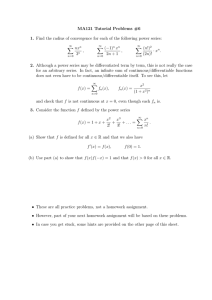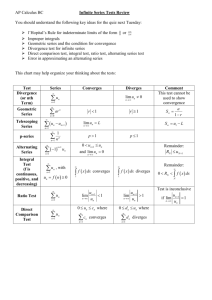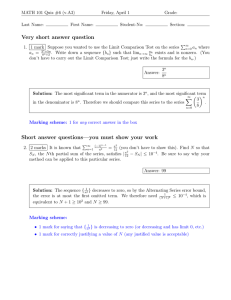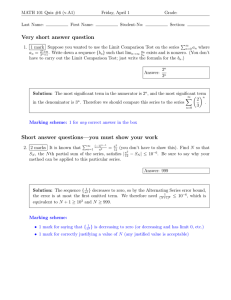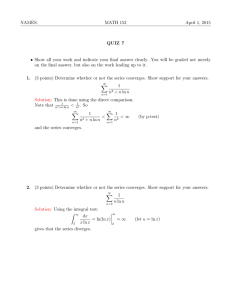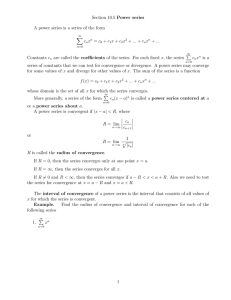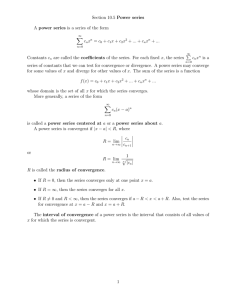Very short answer question
advertisement
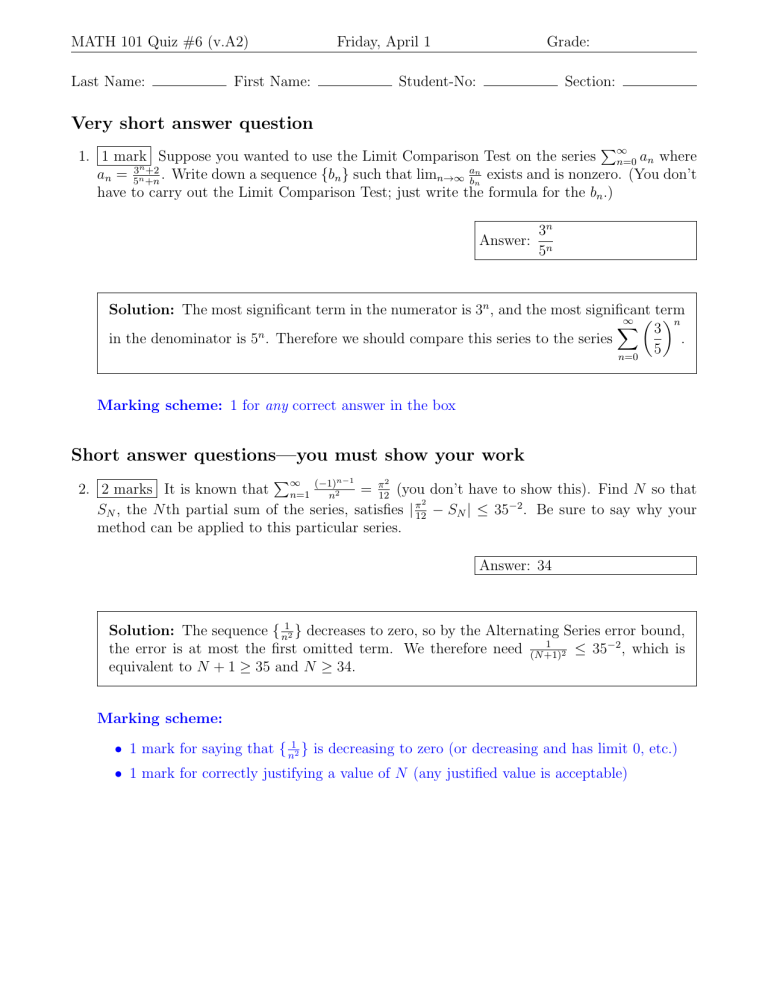
MATH 101 Quiz #6 (v.A2)
Last Name:
First Name:
Friday, April 1
Grade:
Student-No:
Section:
Very short answer question
P
1. 1 mark Suppose you wanted to use the Limit Comparison Test on the series ∞
n=0 an where
n +2
an = 53n +n
. Write down a sequence {bn } such that limn→∞ abnn exists and is nonzero. (You don’t
have to carry out the Limit Comparison Test; just write the formula for the bn .)
Answer:
3n
5n
Solution: The most significant term in the numerator is 3n , and the most significant term
∞ n
X
3
n
.
in the denominator is 5 . Therefore we should compare this series to the series
5
n=0
Marking scheme: 1 for any correct answer in the box
Short answer questions—you must show your work
P
2
(−1)n−1
= π12 (you don’t have to show this). Find N so that
2. 2 marks It is known that ∞
n=1
n2
2
SN , the N th partial sum of the series, satisfies | π12 − SN | ≤ 35−2 . Be sure to say why your
method can be applied to this particular series.
Answer: 34
Solution: The sequence { n12 } decreases to zero, so by the Alternating Series error bound,
1
−2
the error is at most the first omitted term. We therefore need (N +1)
, which is
2 ≤ 35
equivalent to N + 1 ≥ 35 and N ≥ 34.
Marking scheme:
• 1 mark for saying that { n12 } is decreasing to zero (or decreasing and has limit 0, etc.)
• 1 mark for correctly justifying a value of N (any justified value is acceptable)
3. 2 marks Does the series
∞
X
n sin n
n=5
n3 − 1
converge conditionally, converge absolutely, or diverge?
Explain your answer.
Solution: We know that
n sin(n)
n3 −1
≤
n
,
n3 −1
since |sin(n)| ≤ 1 for all n.
Next, we have
n/(n3 − 1)
n3
1
n · n2
=
lim
= lim
=
lim
= 1,
2
3
3
n→∞
n→∞ n − 1
n→∞ 1 − 1/n3
n→∞ n − 1
1/n
P
n
so by the Limit Comparison Test the series ∞
3 −1 converges together with the p-series
n=5 nP
P∞ 1
∞
n sin n
n=5 n2 . By the Comparison Test it follows that
n=5 n3 −1 converges, and hence that
the given series converges absolutely.
lim
Marking scheme:
• 1 point for correctly using a convergence test (Limit Comparison Test or Comparison
Test) on a positive series
• 1 point for stating that the series converges absolutely
Long answer question—you must show your work
4. 5 marks Find the radius of convergence and interval of convergence of the series
n
∞
X
(−1)n x + 3
.
n
+
1
3
n=0
Solution: We have
lim
n→∞
(−1)n+1 /(n + 2) · ((x + 3)/3)n+1
an+1
= lim
n→∞
an
(−1)n /(n + 1) · ((x + 3)/3)n
n+1 x+3
|x + 3|
= lim
=
.
n→∞ n + 2
3
3
Therefore, by the Ratio Test, the series converges when
|x+3|
> 1. In particular, it converges when
3
|x+3|
3
< 1 and diverges when
|x + 3| < 3 ⇐⇒ −3 < x + 3 < 3 ⇐⇒ −6 < x < 0,
and the radius of convergence is R = 3. (Alternatively, one can set cn =
compute L = limn→∞ cn+1
= 13 , so that R = L1 = 3.)
cn
(−1)n
(n+1)3n
and
P
(−1)n
Next, we consider the endpoints 0 and −6. At x = 0 the series is simply ∞
n=0 n+1 ,
which is an alternating series: the signs alternate, and the unsigned terms decrease to
zero. Therefore the series converges at x = 0 by the Alternating Series Test.
At x = −6 the series is
n X
∞
∞
∞
X
X
(−1)n −6 + 3
(−1)n
1
n
=
(−1) =
,
n+1
3
n+1
n+1
n=0
n=0
n=0
n
since (−1)n · (−1)n = (−1)2n = ((−1)2 ) = 1. This series diverges, either by comparison
or limit comparison with the harmonic series (the p-series with p = 1), or directlyPby the
1
Integral Test. (For that matter, it is exactly equal to the standard harmonic series ∞
n=1 n ,
re-indexed to start at n = 0.)
In summary, the interval of convergence is −6 < x ≤ 0, or simply (−6, 0].
Marking scheme:
• 1 mark for using the Ratio Test
• 1 mark for getting R = 3 (radius of convergence)
• 1 mark for showing convergence at x = 0 (any valid way)
• 1 mark for showing divergence at x = −6 (any valid way)
• 1 mark for writing the interval of convergence (in either form)

